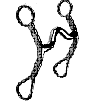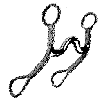|
Severity Ratio of Curb Bits Most people have been taught that the longer the
cheek piece of the curb, the more powerful the bit, but this is not
exactly true. The longer the cheek piece (the part above the
mouthpiece) is compared to the lower part of the shank, the more
powerful the bit. A 1:1 ration would be the strongest bit you could
buy. Most manufacturers make curbs in a 1:2 (top:bottom) to 1:3
ratio. A 1:2.5 bit is stronger than a 1:3, but less strong than a
1:2. It has also been generally agreed that the curb chain should
allow 1-2 fingers between the chain and the chin, but that really
only applies to horses with perfect chin conformation. A better
method for getting the tension right in all horses is to hold the
bit at a 45 degree angle in the horses mouth and then hook the curb
chain so that it is flush (but not tight) against the chin. Then,
when the bit is used, the poll pressure will be applied before the
curb kicks in, which is the desired action. The leverage and severity of a curb bit is determined by measuring the ratio between the measurement of length of the cheek piece of the bit (that part above the mouthpiece) and compare it to the length of the shank (that part below the mouth piece)
This bit has a larger ratio of cheek length and is, therefore, less severe and exerts less leverage tan the next one. More forgiving in bad hands.
This bit has a smaller ratio between cheek length and shank length and is, therefore more severe and exerts more leverage than the first one. Better have good hands.
The leverage and severity of a curb bit is also determined by the angle between the shank and an imaginary line drawn straight down along the bit from bridle ring to the butt of the mouthpiece. The greater the angle, the less leverage and less severe the curb is.
This bit has a larger angle and is less severe. More forgiving in bad hands.
|



 This bit has a smaller angle and is more severe.
Better have good hands.
This bit has a smaller angle and is more severe.
Better have good hands.